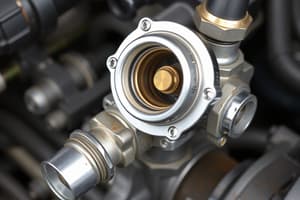Podcast
Questions and Answers
What could cause accelerated wear on one side of the final drive sprocket teeth?
What could cause accelerated wear on one side of the final drive sprocket teeth?
- Worn out bushings
- High-speed operation exceeding limits
- Improper lubrication of the sprocket
- Loose track and sprocket misalignment (correct)
What is a likely cause for a dozer drifting to the right or left while driving straight?
What is a likely cause for a dozer drifting to the right or left while driving straight?
- Improper oil levels in hydraulic system
- Uneven weight distribution
- Defective steering clutches
- One track tighter than the other (correct)
Which issue could lead to accelerated wear of track pins, bushings, and track links?
Which issue could lead to accelerated wear of track pins, bushings, and track links?
- Excessive lubrication
- Underutilization of the track
- Track adjustment too tight (correct)
- Too much weight applied to tracks
Which condition is likely associated with frequent packing of the track during operation?
Which condition is likely associated with frequent packing of the track during operation?
What could cause a track to whip excessively during operation?
What could cause a track to whip excessively during operation?
What component assists the operation of each brake?
What component assists the operation of each brake?
What happens when oil pressure exceeds 50 PSI?
What happens when oil pressure exceeds 50 PSI?
Which mechanism is responsible for the brake band engagement?
Which mechanism is responsible for the brake band engagement?
What is the main function of the relief valve in the hydraulic control mechanism?
What is the main function of the relief valve in the hydraulic control mechanism?
Where can you find specific procedures for adjusting brakes?
Where can you find specific procedures for adjusting brakes?
What keeps the pressure plate steel discs against the inner drum in an engaged steering clutch?
What keeps the pressure plate steel discs against the inner drum in an engaged steering clutch?
Which component is responsible for sending pressure oil to the steering clutch pistons?
Which component is responsible for sending pressure oil to the steering clutch pistons?
What is a possible fault if a machine will not turn in one direction?
What is a possible fault if a machine will not turn in one direction?
What occurs when the steering clutches are disengaged?
What occurs when the steering clutches are disengaged?
Which component is NOT part of the steering clutch assembly?
Which component is NOT part of the steering clutch assembly?
What can cause slow steering in a machine?
What can cause slow steering in a machine?
What is the function of the hydraulic control valve in the steering system?
What is the function of the hydraulic control valve in the steering system?
Which adjustment procedure should be followed for specific control linkage adjustments?
Which adjustment procedure should be followed for specific control linkage adjustments?
Flashcards are hidden until you start studying
Study Notes
Track Problems
- Accelerated wear on one side of the final drive sprocket teeth caused by track misalignment, loose track, or sprocket misalignment from improper installation.
- Accelerated wear on the idler or rollers due to track misalignment or idler misalignment from improper installation.
- Track pins, bushings, and track links experience accelerated wear from tight track adjustment, misalignment, excessively worn sprocket teeth, or high-speed operation.
- Loss of draw bar power caused by improper track adjustment or overly tight track.
- Dozer drift in either direction when moving straight, resulting from improper track adjustment, uneven track tension, track misalignment, or steering clutch adjustment needed.
- Frequent track packing during operation linked to improper or overly loose track adjustment.
- Noisy track operation attributed to improper or loose track adjustment.
- Excessive track whipping occurs when track adjustment is improper or too loose, or if the idler is seized in the retracted position.
- Track can be thrown off during operation due to improper track adjustment or excessive looseness.
Operation - Brakes
- Brakes assist steering clutches for turning the machine.
- Each brake operates with assistance from a hydraulic control mechanism.
- Both brakes can remain engaged via a PAW on the brake linkage.
- Engaged brake band operates as mechanical linkage drives the hydraulic control mechanism piston.
- Released brake pedal allows springs to adjust the mechanical linkage and brake pedal, detaching the brake band from the steering clutch drum.
Hydraulic Control Mechanism
- The relief valve cools and lubricates brakes while controlling oil to brake bands at a specific pressure.
- Oil pressure over 50 PSI triggers a valve movement, allowing excess oil to flow to the left steering clutch compartment.
- Relief valve regulates oil pressure to both the hydraulic control valve and the brake mechanism.
Brake System Faults and Adjustment Procedures
- Adjust brakes according to the manufacturer's equipment manual for accurate procedures.
- Parking brakes need adjustment per the manufacturer's specifications.
- The engagement mechanism of the brake requires specific adjustment procedures as outlined in the manufacturer’s manual.
Mechanical Steering Components & Operation
- Key mechanical components include bearing cage, hub, pistons, inner drum, springs, steel discs, disc assembly, and pressure plate.
- Engaged steering clutches exert pressure through springs to transfer power from the inner drum to the outer drum.
- Disengaged clutches allow hydraulic pressure to move pistons outward, disengaging the clutches.
- Hydraulic control valve receives pressure oil from the transmission oil pump, controlling oil flow to steering clutch pistons.
Steering System Faults & Adjustment Procedures
- Equipment may not turn in one direction due to incorrect steering control linkage adjustment, clutches leaking, or low oil pressure.
- A damaged spine on the steering clutch may prevent equipment rotation when both clutches are engaged.
- Slow steering may result from worn or damaged brake linings.
- Adjustments for control linkages should follow the manufacturer's equipment manual.
Brake Components & Operation
- Key brake components include spring, brake lock pawl, ratchet, brake band strut, and brake engaging mechanism.
Studying That Suits You
Use AI to generate personalized quizzes and flashcards to suit your learning preferences.




